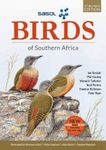By
Keith
4 Feb 2016
Written for Paperback
Being about the same size as the UK, Ghana is one of the most accessible countries in West Africa and (apart from a few inter-ethnic scuffles and land disputes in the far north) it is a relatively calm and safe destination. In a survey five years ago only 5% of travelling birders had visited Ghana, but with the arrival of an excellent field guide
Birds of Ghana, by Nik Borrow and Ron Demey (Helm, 2010) and competitively-priced birding tours, Ghana has become the fastest-growing bird tourism destination in West Africa – despite the fact that none of the species present are endemic. However the attraction has to be all but four of the Upper Guinea endemics that are found from here and further west, plus 179 Guineo-Congolian forest species.
Despite being a great birding destination, Ghana is not immune to the threats that occur in much of Africa. In the last 100 years six species of birds have ceased to occur in the country, and several others are now seriously threatened. In fact forty-nine species are considered to be of global or regional conservation concern, and on a recent visit I personally witnessed the way that some natural habitats are being decimated at an alarming rate.
Collectors of country avifaunas will probably already possess
The Birds of Ghana: An Annotated Checklist by L.G. Grimes (BOU, 1987). Much has been discovered in the 27 years that have passed, and in addition the authors question some past records and assumptions about status. They are in a good position to do so having camped for several days at a time in almost 100 locations around the country – covering all of the districts and every habitat type. It is no wonder therefore that they were able to include a gazetteer of more than 860 localities.
Anyone who has used the Dowsetts’ other publications covering
Malawi and
Zambia will know what to expect, as they combine their own original research with the records of local and visiting ornithologists. They are nothing if not thorough and as an ornithological duo they achieve more in just a few years than some bird clubs manage to do over several generations!
An initial 116-page introductory section includes chapters which review the vegetation and major bird habitats, biogeography, migration, conservation challenges and the history of ornithological exploration in Ghana.
The main part of the book describes the status of 750 species, including around 100 species that spend our winter in the country and a further 50 or so that pass through on passage or as vagrants. The main attraction will be the maps which clearly display the distribution of each species (except rarer vagrants) by half-degree squares. While the maps in Borrow and Demey give a more colourful indication on where species are likely to be found these new maps are based on actual record locations – albeit placed centrally within a square.
The text complements the maps very well, summarising succinctly, what is known of ecology, status, movements, breeding seasons, taxonomy and conservation for each species. There are twenty-one pages of colour photos illustrating habitats and some typical species.
The authors searched extensively to be sure that they reviewed all of the published records – and other data from private notebooks. Wherever possible they worked with Llewellyn Grimes to check back on the details of original sightings in his checklist, and as a result they chose to consider a number of records as not proven. The outcome is a bibliography of around 600 references. Ringing recoveries affecting Ghana are analysed and maps of recoveries have been included – emphasizing Ghana’s position as a key location for many European migrants.
One might think that with three major atlases under their belts the authors would be looking to enjoy some time off, but they now have neighbouring Togo in their sights, and so before too long yet another African country will put under a much needed spotlight.




































